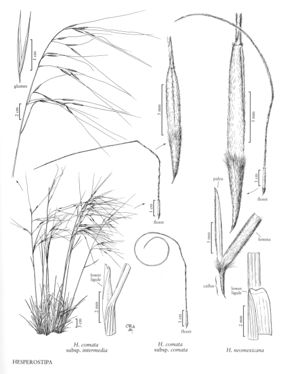familyPoaceae
subfamilyPoaceae subfam. Pooideae
genusHesperostipa
speciesHesperostipa comata
subspeciesHesperostipa comata subsp. comata
Difference between revisions of "Hesperostipa comata subsp. comata"
Treatment appears in FNA Volume 24. Treatment on page 158.
FNA>Volume Importer |
imported>Volume Importer |
||
| (8 intermediate revisions by 2 users not shown) | |||
| Line 1: | Line 1: | ||
{{Treatment/ID | {{Treatment/ID | ||
|accepted_name=Hesperostipa comata subsp. comata | |accepted_name=Hesperostipa comata subsp. comata | ||
| − | |accepted_authority= | + | |accepted_authority= |
|publications= | |publications= | ||
|basionyms= | |basionyms= | ||
| Line 15: | Line 15: | ||
-->{{Treatment/Body | -->{{Treatment/Body | ||
| − | |discussion=<p>Hesperostipa comata subsp. comata grows on well-drained soils of cool deserts, grasslands, and sagebrush associations, at elevations of 200-2500 m. It is widespread and often abundant in western and central North America, particularly in disturbed areas. It is similar to H. neomexicana, differing primarily in having awns that are either not hairy or have hairs that are no more than 0.5 mm long, and in having thinner, longer ligules. Intermediates to H. neomexicana exist but are not common.</p> | + | |discussion=<p><i>Hesperostipa comata </i>subsp.<i> comata</i> grows on well-drained soils of cool deserts, grasslands, and sagebrush associations, at elevations of 200-2500 m. It is widespread and often abundant in western and central North America, particularly in disturbed areas. It is similar to <i>H. neomexicana</i>, differing primarily in having awns that are either not hairy or have hairs that are no more than 0.5 mm long, and in having thinner, longer ligules. Intermediates to <i>H. neomexicana</i> exist but are not common.</p> |
|tables= | |tables= | ||
|references= | |references= | ||
| Line 24: | Line 24: | ||
-->{{#Taxon: | -->{{#Taxon: | ||
name=Hesperostipa comata subsp. comata | name=Hesperostipa comata subsp. comata | ||
| − | + | |authority= | |
| − | |authority= | ||
|rank=subspecies | |rank=subspecies | ||
|parent rank=species | |parent rank=species | ||
| Line 31: | Line 30: | ||
|basionyms= | |basionyms= | ||
|family=Poaceae | |family=Poaceae | ||
| + | |illustrator=Cindy Roché;Annaliese Miller | ||
| + | |illustration copyright=Utah State University | ||
|reference=None | |reference=None | ||
|publication title= | |publication title= | ||
|publication year= | |publication year= | ||
|special status= | |special status= | ||
| − | |source xml=https:// | + | |source xml=https://bitbucket.org/aafc-mbb/fna-data-curation/src/200273ad09963decb8fc72550212de541d86569d/coarse_grained_fna_xml/V24/V24_218.xml |
|subfamily=Poaceae subfam. Pooideae | |subfamily=Poaceae subfam. Pooideae | ||
|tribe=Poaceae tribe Stipeae | |tribe=Poaceae tribe Stipeae | ||
Latest revision as of 16:22, 11 May 2021
Lower cauline nodes usually concealed by the sheaths. Panicles often partially included in the uppermost sheath at maturity. Awns 75-225 mm, terminal segment 40-120 mm, sinuous to curled. 2n = 38, 44, 46.
Discussion
Hesperostipa comata subsp. comata grows on well-drained soils of cool deserts, grasslands, and sagebrush associations, at elevations of 200-2500 m. It is widespread and often abundant in western and central North America, particularly in disturbed areas. It is similar to H. neomexicana, differing primarily in having awns that are either not hairy or have hairs that are no more than 0.5 mm long, and in having thinner, longer ligules. Intermediates to H. neomexicana exist but are not common.
Selected References
None.
Lower Taxa
None.
... more about "Hesperostipa comata subsp. comata"
